The OCEAN2020 project, managed by a 42 partner consortium from 15 EU countries, has successfully launched its first maritime demonstration in the Gulf of Taranto, Italy.
The European Defenbce Agency say that the OCEAN2020 Live Sea Demonstration involves a total of 9 unmanned assets and six naval units from Italy, Spain, Greece and France.
“The deployment of manned and unmanned systems, when integrated with satellite and communication networks, aims to enhance overall maritime situational awareness and build a comprehensive picture of developing situations for military decision-makers.”
Pierre Delsaux, Deputy Director General, DG GROW – European Commission, said:
“Today Ocean 2020 is demonstrating its technical achievements, but also that joint research and development at the EU level works. With the preparatory action on defence research we started small. But it helped us to gain valuable experience for the fully-fledged European Defence Fund in place in 2021 to further strengthen the competitiveness of our defence industries.”
Led by Leonardo, the OCEAN2020 (Open Cooperation for European mAritime awareNess) maritime initiative brings together technical specialists in the maritime domain covering the observing, orienting, deciding and acting operational tasks.

According to a news brief:
“In the Mediterranean Sea Demonstration, OCEAN2020 brings together data and information from a variety of sources; 9 unmanned assets – four aircraft, three surface and two underwater, six naval units, five satellites for communication and surveillance, four National Maritime Operations Centres (MOC), two ground communication networks and a prototype of a European Maritime Operations Centre (EU MOC) to build a comprehensive maritime picture.
The two-day live demonstration is the latest phase in the ambitious project which aims to demonstrate enhanced situational awareness in a maritime environment through the integration of legacy and new technologies for unmanned systems. OCEAN2020 aims to achieve operational and technical objectives, these range from enhanced situational awareness, autonomy, cost effectiveness and increased interoperability for joint missions also using protocols compatible with NATO standards. The variety of assets involved in OCEAN2020 highlights how collaborative autonomy between multi-domain unmanned vehicles can provide a force multiplier.”
Giovanni Soccodato, Chief Strategic Equity Officer at Leonardo, speaking on behalf of OCEAN2020 Consortium, said:
“OCEAN2020 is an incredibly ambitious project. To deliver it, we are bringing together a pan-European team of experts, each of which is contributing its own area of world-class capabilities. Operationally, this project is important demonstrating the possibility to enhance maritime surveillance – of vital interest to European defence – integrating unmanned platforms with traditional systems.
More broadly, OCEAN2020 demonstrates the potential and the true spirit of European collaboration in the defence sector, having enabled a real partnership of large and small industry, academia and defence ministries from across the continent.”


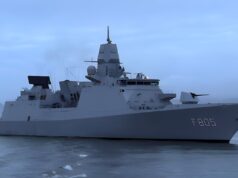
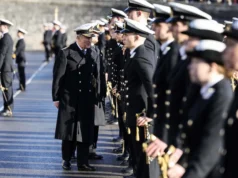
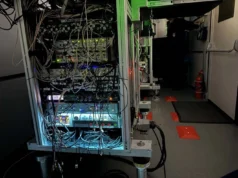
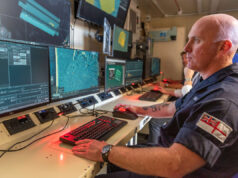
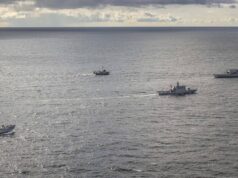

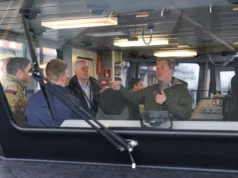
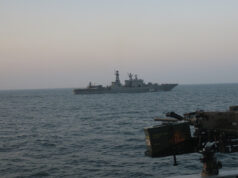
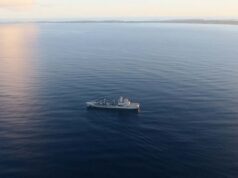
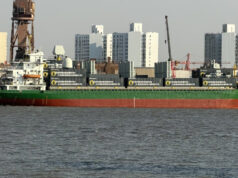

The UK has to up its game on the UAV front particularly for the RN. Maybe stuff is happening in secret or I missed stuff (or perhaps have only been registering the disappointing stuff) but the last news I remember on RN UAV activities was the MoD cancelling further funding for the ScanEagle test project a few years ago.
It actually makes me sad to see articles like this on UAV stuff when it’s not the UK/RN involved because it reminds me of how little the UK seems to be doing, at least publicly.
This article even has a Schiebel S-100 (I think) in the render which is one platform that is a bit of a hot button for me because, if procured together with appropriate sensors (and there are quite a few options now that it can carry), it could have the ability to massively increase the surveillance reach of things like the Rivers and the Bays. (The Bays obviously can host a Wildcat if they have the portable hangar installed but a decent UAV would still substantially augment that asset and give better persistence.)
Actually, we are still in the EU as of today! Are we one of the 15 countries involved? Perhaps my rant above was premature but even if we are one of the 15 we still need to turn research into actually procuring stuff.
search for apollo Julian and you will see the royal navy is still very much interested in autonomous warfare
Thanks Dean. Interesting and good stuff but I was careful in my rant to specifically refer to UAV. If I’ve found links to the right project (e.g. https://www.thalesgroup.com/en/united-kingdom/news/royal-navy-meets-autonomous-boat-apollo) that is strictly USV which I was aware of.
I’ve been following the MCM stuff with some interest, mainly in the hope that whatever mothership is chosen when Hunt/Sandown replacement happens might have more multi-role flexibility. The Hunts & Sandowns seem to sometimes get pushed into roles that they are not really fully equipped to perform, stuff like Gulf escorting being a case in point. Something like a Venari 85 equipped with a suitable UAV and even slightly better armed than a single 30mm would be a big step up if/when pushed into other roles due to unavailability of anything else.
I should also perhaps have further qualified “UAV” as “small-ship-deployable UAV” to preclude existing UAV stuff that I know about such as Watchkeeper and obviously the really big RAF attack drone stuff both current and planned.
Royal navy isnt participating, mostly Med navies, however two British companies are, QinetiQ and Autonaut.
In October 2018 the RAN stood up 822X Squadron in the Fleet Air Arm to operate UAVs out of Nowra. The Squadron will operate the Insitu ScanEagle and the Schiebel S-100 Camcopter.
The Scheibel S-100 UAV will be the primary air asset operated from the 12 new Arafura Class OPVs under construction for the RAN.
Like the Rivers they have a flight deck with no hangar but are capable of operating the S-100s out of containers on the flight deck.
This will greatly extend the ISR horizon for the RANs OPVs and be an effective fleet multiplier allowing them to cover a far larger area on a single patrol.
The S-100 can be fitted with a pair of Thales Lightweight Multi-role Missiles (LMM) to provide a maritime strike option against small targets, for example in the anti-piracy role,
http://images.defence.gov.au/20181025ran8098978_311.jpg
Yup. The RAN are doing really good things and there’s also some interesting indigenous Australian technology too e.g. Sentient Vision’s ViDAR (http://www.sentientvision.com/products/vidar-2-2/) which you probably know of but link added for others.
The RN could learn a lot of lessons from the RAN in this small ship-launched UAV area. What the RAN are doing with containerised S-100 on the Arafura Class (which I didn’t know about – thanks for that) is exactly my wish for the River Batch 2. From the look of the Arafura Class the River B2 is if anything a better match since it has that designed-in space aft of the ribs for a standard ISO container either side of the crane with no encroachment at all onto the flight deck. It looks as if the Arfura might need the container to encroach a bit but I’m not 100% sure from looking at pictures of the model. In any event I am sure the RAN will make it work but River B2 and containerised S-100 really are a match made in heaven.
I wonder how realistic LMM on S-100 is in practice? Once a pair of LMM are strapped on how much payload weight is left over for a decent sensor package plus an onboard designator or does something else need to designate the target i.e.could it do an over-the-horizon attack all on its own? Perhaps that isn’t a huge limitation, or maybe the payload capacity is sufficient and it isn’t a limitation at all. I’m just curious where the limits lie. (And obviously when talking about payload it is within limits a trade off with endurance.)
A recent interview by the RAN Chief of Navy, Mike Noonan with Australia Defence Magazine (ADM) gives some insight into the importance the RAN attaches to developing UAV capabilities:
ADM: What type of UAS capability is being sought under Sea 129/5 (rotary and/or fixed wing)? What will the acquisition methodology be (agile/smart buyer)?
Noonan: “Sea 129 Phase 5 is a really important way of understanding what the emerging UAS technologies are and how we will incorporate them into our Navy. I think it would be fair to say that we don’t have all answers to that yet. It’s part of the reason that we stood up the new Navy squadron 822X last year; it’s having an ability to learn and fail fast if necessary but also evolve quickly those capabilities that we want to get to sea.
In terms of that project, we’re looking to procure enough systems to support probably up to 12 operational flights at sea in the next decade and we’re looking at how we’ll introduce those. That’ll be a mix of flights, both in the OPVs and also in the Hunter class frigate. I don’t know that we will find one system that will meet all of our needs across the fleet, so I’m expecting that we’ll see a mix of both rotary and fixed wing. You’re probably familiar with what we’ve done already with ScanEagle and Camcopter and that’s all been pretty successful in terms of learning, not just about the mechanical and the aeronautical capabilities of those platforms but how we will ultimately integrate them as part of the ships’ weapons and sensor systems.”
At the other end of the spectrum the RAN is also looking to develop high-end capabilities notably anti-ballistic missile defence for its current 3 (Hobart) and future 9 (Hunter T26) Aegis equipped ships.
ADM: What about the future of SM-6? Is Navy looking to acquire an anti-ballistic missile capability?
Noonan: “Yes, it is. Absolutely, as part of where we’re going under our Future Maritime Based Joint Area Weapons System, SM-6 will be part of that. It’s been selected specifically to meet Navy’s future requirements and it is already successfully integrated into other versions of the Aegis Combat System. We’ll see this as part of the growth path for the Hobart class destroyer and also the Hunter class frigates and even though it’s not a stipulated capability for the Hunter class at this point time, the Aegis Combat System that we will have in that frigate will be capable of interfacing with that missile. So it’s a significant capability but it’s absolutely a vital part of our future air warfare capability.”
eu? It is an empire!
This eu is a disgusting empire.I was always told empire were and are bad.